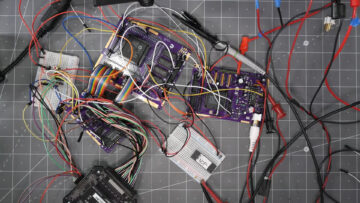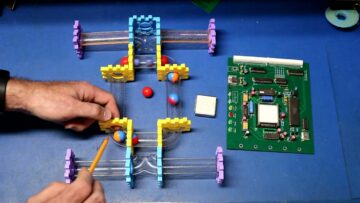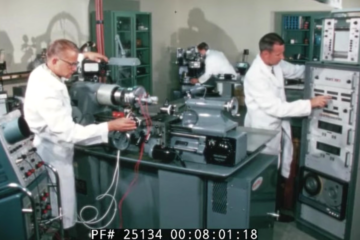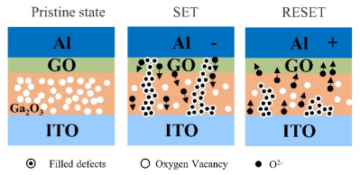There are probably very few people on this globe who at some point in time haven’t heard the term ‘Higgs Boson’ zip past, along with the term ‘God Particle’. As during the 2010s the scientists at CERN were trying to find evidence for the existence of this scalar boson and with it evidence for the existence of the Higgs field that according to the Standard Model gives mass to gauge bosons like photons, this effort got communicated in the international media and elsewhere in a variety of ways.
Along with this media frenzy, the physicist after whom the Higgs boson was named also gained more fame, despite Peter Higgs already having been a well-known presence in the scientific community for decades by that time until his retirement in 1996. With Peter Higgs’ recent death after a brief illness at the age of 94, we are saying farewell to one of the big names in physics. Even if not a household name like Einstein and Stephen Hawking, the photogenic hunt for the Higgs boson ended up highlighting a story that began in the 1960s with a series of papers.
Breaking Symmetry
Much of what we can observe around us is based around symmetry, whether it’s our own bodies, plants or planets. Yet the question that should be asked here is: symmetrical on what level? A tree branch is symmetrical, up till where it branches off, and its trunk is symmetrical except where it’s not. Similarly, our own bodies like to break symmetry so that we only have one liver and one heart, despite having two eyes and two brain hemispheres, generally speaking. This breaking of symmetry is something that can be observed on any level, including that of the Universe itself on a fundamental level.
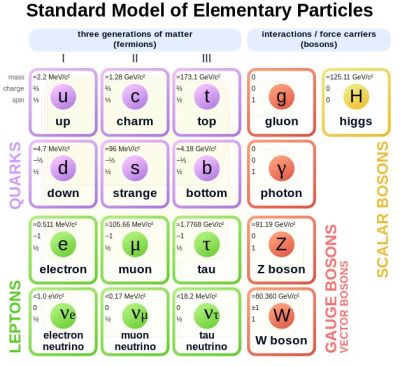 When the Universe first came into existence, for a brief moment it would have existed in perfect symmetry in its high energy state, but as we can observe today this state did not persist. Rather than maintain this perfect state of symmetry, something caused this symmetry to spontaneously break and separate into areas of distinct mass. These areas would coalesce into nebulae, stars and ultimately the galaxies courtesy of which we are able to contemplate our place in the Universe today. Figuring out the exact nature of the symmetry breaking that led to this was the topic of much discussion among particle physicists during the 20th century.
When the Universe first came into existence, for a brief moment it would have existed in perfect symmetry in its high energy state, but as we can observe today this state did not persist. Rather than maintain this perfect state of symmetry, something caused this symmetry to spontaneously break and separate into areas of distinct mass. These areas would coalesce into nebulae, stars and ultimately the galaxies courtesy of which we are able to contemplate our place in the Universe today. Figuring out the exact nature of the symmetry breaking that led to this was the topic of much discussion among particle physicists during the 20th century.
Essentially, what could cause the continuous symmetry across spacetime to break? Of most importance here is gauge symmetry, which gives rise to the strong, weak and electromagnetic forces. The strong interaction is explained by quantum chromodynamics using the quark model. The weak (W and Z bosons) and electromagnetic (photons) forces are unified in the electroweak interaction, but these particles require an additional mechanism for their formation. Initially the Standard Model predicted the W and Z bosons to have no rest mass, while in reality they have quite significant masses. To resolve this, the Higgs mechanism was introduced, which involved the Higgs field and a short-lived scalar boson particle that had no spin, no charge, but a significant mass which could be imparted on gauge bosons by breaking electroweak symmetry.
Three Papers
The ‘Sombrero Potential’ as seen with the Higgs mechanism.
” data-medium-file=”https://platoaistream.net/wp-content/uploads/2024/04/remembering-peter-higgs-and-the-gravity-of-his-contributions-to-physics.png” data-large-file=”https://platoaistream.net/wp-content/uploads/2024/04/remembering-peter-higgs-and-the-gravity-of-his-contributions-to-physics-1.png?w=464″ class=”size-medium wp-image-673885″ src=”https://platoaistream.net/wp-content/uploads/2024/04/remembering-peter-higgs-and-the-gravity-of-his-contributions-to-physics.png” alt=”The ‘Sombrero Potential’ as seen with the Higgs mechanism.” width=”400″ height=”392″ srcset=”https://platoaistream.net/wp-content/uploads/2024/04/remembering-peter-higgs-and-the-gravity-of-his-contributions-to-physics-1.png 464w, https://platoaistream.net/wp-content/uploads/2024/04/remembering-peter-higgs-and-the-gravity-of-his-contributions-to-physics-1.png?resize=250,245 250w, https://platoaistream.net/wp-content/uploads/2024/04/remembering-peter-higgs-and-the-gravity-of-his-contributions-to-physics-1.png?resize=400,392 400w” sizes=”(max-width: 400px) 100vw, 400px”>
A fascinating aspect of the Higgs mechanism’s history is that the symmetry breaking aspect behind it was practically simultaneously explored by three different teams of physicists during the early 1960s and published in Physical Review Letters in 1964. The first article was by François Englert and Robert Brout, titled Broken Symmetry and the Mass of Gauge Vector Mesons. The second was by Peter W. Higgs and titled Broken Symmetries and the Masses of Gauge Bosons. Finally, the third paper was by Gerald Guralnik, Carl Hagen and Tom Kibble (GHK), and titled Global Conservation Laws and Massless Particles.
Although these papers sound incredibly similar, they each propose a different approach to how mass could arise in vector gauges without breaking gauge invariance, i.e. the Lagrangian field of the system remains unchanged under local transformations (invariant Lagrangian). The basic theory behind spontaneous symmetry breaking had been published by Yoichiro Nambu in 1960, which led to this being worked into a mechanism which could resolve the mass-less W and Z boson conundrum. Of these, the Higgs and GHK papers contained the equations for a hypothetical field which would become known as the Higgs field, along with the newly proposed scalar boson. Here another major difference is that in the Higgs paper the scalar boson has a large mass, while in the GHK paper it is massless, akin to the Nambu-Goldstone boson quasi-particle proposed by Yoichiro Nambu.
After these papers, both Steven Weinberg and Abdus Salam showed independently from each other in 1967 how the Higgs mechanism could break the electroweak symmetry, leading to the formulation of the Standard Model as we know it today. It also cleared the way for figuring out an experiment that could provide evidence for the existence of the Higgs field, using the mass of its associated boson.
Collision Debris
How do you detect a sub-atomic particle? The answer is clearly to build the biggest scientific instruments known to man, as it wasn’t until the Large Hadron Collider (LHC) with its 27 kilometer circumference finished construction in 2008 that humankind had a particle collider with enough energy behind it to conclusively test for the existence of the Higgs boson. With the first collisions in 2010, the race was on to detect this elusive scalar boson with its suspected massive mass. The only snag was that this boson was expected to exist so briefly that any detector used would only be able to detect its decay products.
Each decay process creates what is called a ‘decay channel’, which is effectively a particular signature. Because of how rarely a Higgs boson was thought to form, many collisions would be required for the two main particle detectors at the LHC (ATLAS and CMS) to collect enough of these signatures to establish with some certainty (typical five sigma rule) that the channels detected were indeed from this new boson. With the amount of data generated from each collision and the two particle detectors this was akin to searching for a needle in a haystack.
Then in 2012 the five sigma confidence level was reached and exceeded, leading to the aforementioned media frenzy, as many had caught on that something monumental was about to happen in the world of particle physics with potentially far-reaching consequences. As the Higgs boson’s ~125 GeV/c2 mass was announced, the world had mostly moved on already, beyond understanding that the ‘god particle’ had been found. Yet to particle physicists this was a monumental event, even if many of those present during the days in the 1960s and 1970s when these predictions were laid were no longer around to witness it.
The Standard Model was now complete, other than the minor niggle of this ‘gravity’ thing and what might be gravitons.
Beyond The Physics
To Peter Higgs, the field of particle physics was much of his life, though he also enjoyed hiking and was outspoken in a number of areas. It was at the UK’s Campaign for Nuclear Disarmament (CND) that he met fellow activist Jody Williamson whom he’d end up marrying. He also was a member of Greenpeace and identified as an atheist, more interested in reality of science than any kind of ideology of dogma. This led him to quit CND as soon as they began to campaign against nuclear power (“a really bad mistake”) and similarly with Greenpeace when they began to oppose genetically engineered organisms (GMO). Calling their actions ‘hysterical’, he had to resign his membership.
This made it rough on him when the term ‘god particle’ began to buzz around. The term itself seems to come from Leon M. Lederman’s book The God Particle, due to how the Higgs boson is so elusive and yet essential to the very existence of the Universe and everything in it. Without the Higgs field and mechanism there would be no galaxies, no planets or suns, or life to wonder at its place in it all. As this name led to many confusing the scalar boson with something religiously profound, including evidence for the existence of one’s favorite deity or deities, it really rubbed Peter Higgs the wrong way.
With the subsequent years after the discovery of the Higgs boson even more details about it were filled in, cementing the Higgs mechanism’s place in the Standard Model and gave Peter Higgs the knowledge that his theories had indeed been correct, an honor which he shared with other physicists involved in the decades-long discovery. Although he won’t be around to see what comes next, it are the efforts from scientists like Peter Higgs which will inspire future generations of scientists for centuries to come.
- SEO Powered Content & PR Distribution. Get Amplified Today.
- PlatoData.Network Vertical Generative Ai. Empower Yourself. Access Here.
- PlatoAiStream. Web3 Intelligence. Knowledge Amplified. Access Here.
- PlatoESG. Carbon, CleanTech, Energy, Environment, Solar, Waste Management. Access Here.
- PlatoHealth. Biotech and Clinical Trials Intelligence. Access Here.
- Source: https://hackaday.com/2024/04/15/remembering-peter-higgs-and-the-gravity-of-his-contributions-to-physics/
- :has
- :is
- :not
- :where
- $UP
- 1
- 13
- 1960
- 1996
- 2008
- 2010
- 2010s
- 2012
- 20th
- 245
- 27
- 321
- 400
- 455
- 628
- a
- Able
- About
- about IT
- According
- across
- actions
- Activist
- Additional
- After
- against
- age
- All
- along
- already
- also
- Although
- among
- amount
- an
- and
- announced
- Another
- answer
- any
- approach
- Archive
- ARE
- areas
- arise
- around
- AS
- asked
- aspect
- associated
- At
- Bad
- based
- basic
- BE
- because
- become
- been
- began
- behind
- being
- Beyond
- Big
- Biggest
- bodies
- book
- boson
- both
- Brain
- Branch
- branches
- Break
- Breaking
- briefly
- build
- but
- by
- called
- calling
- came
- Campaign
- CAN
- Carl
- caught
- Cause
- caused
- cementing
- centuries
- Century
- CERN
- certainty
- channels
- charge
- clearly
- CO
- coalesce
- collect
- collision
- come
- comes
- communicated
- community
- complete
- confidence
- confusing
- Consequences
- CONSERVATION
- construction
- contained
- continuous
- contributions
- conundrum
- correct
- could
- courtesy
- creates
- data
- Days
- Death
- decades
- Despite
- details
- detect
- detected
- DID
- difference
- different
- discovery
- discussion
- distinct
- do
- due
- during
- e
- each
- Early
- effectively
- effort
- efforts
- einstein
- elsewhere
- end
- ended
- energy
- engineered
- enjoyed
- enough
- equations
- essential
- establish
- Ether (ETH)
- Even
- Event
- everything
- evidence
- exact
- exceeded
- Except
- exist
- existed
- existence
- expected
- experiment
- explained
- Explored
- Eyes
- FAME
- far-reaching
- farewell
- fascinating
- Favorite
- fellow
- few
- field
- filled
- Finally
- Find
- finished
- First
- five
- For
- Forces
- form
- formation
- formulation
- found
- frenzy
- from
- fundamental
- future
- gained
- Galaxies
- gauge
- gave
- generally
- generated
- generations
- gives
- globe
- God
- got
- gravity
- Greenpeace
- had
- happen
- Have
- having
- he
- heard
- Heart
- hemispheres
- here
- High
- highlighting
- hiking
- him
- his
- history
- honor
- household
- How
- HTML
- HTTPS
- hunt
- i
- identified
- if
- illness
- importance
- in
- Including
- incredibly
- indeed
- independently
- initially
- inspire
- instruments
- interaction
- interested
- International
- into
- introduced
- involved
- IT
- ITS
- itself
- jpg
- kilometer
- Kind
- Know
- knowledge
- known
- laid
- large
- Laws
- leading
- Led
- Level
- Life
- like
- Liver
- local
- longer
- made
- Main
- maintain
- major
- man
- many
- marrying
- Mass
- masses
- massive
- max-width
- mechanism
- Media
- member
- membership
- met
- might
- minor
- model
- moment
- monumental
- more
- most
- mostly
- moved
- much
- name
- Named
- names
- Nature
- New
- newly
- next
- no
- now
- nuclear
- Nuclear power
- number
- observe
- observed
- of
- off
- on
- ONE
- only
- oppose
- or
- organisms
- Other
- our
- out
- own
- Paper
- papers
- particle
- particular
- past
- People
- perfect
- Peter
- Photons
- PHP
- physicist
- Physics
- Place
- Planets
- plants
- plato
- Plato Data Intelligence
- PlatoData
- Point
- potential
- potentially
- power
- practically
- predicted
- Predictions
- presence
- present
- probably
- process
- Products
- profound
- propose
- proposed
- provide
- published
- Quantum
- question
- quite
- Race
- rarely
- rather
- reached
- Reality
- really
- recent
- remains
- remembering
- require
- required
- resolve
- REST
- retirement
- review
- Rise
- ROBERT
- Rule
- saying
- Science
- scientific
- scientists
- searching
- see
- seems
- seen
- separate
- Series
- shared
- should
- showed
- Sigma
- signature
- Signatures
- significant
- similar
- Similarly
- simultaneously
- snag
- So
- some
- something
- Soon
- Sound
- speaking
- Spin
- standard
- Stars
- State
- Stephen
- steven
- Story
- strong
- subsequent
- suspected
- symmetry
- system
- teams
- term
- test
- than
- that
- The
- the world
- their
- theory
- There.
- These
- they
- thing
- this
- those
- though?
- thought
- three
- till
- time
- titled
- to
- today
- tom
- topic
- transformations
- tree
- trying
- two
- typical
- Ultimately
- unchanged
- under
- understanding
- unified
- Universe
- until
- us
- used
- using
- variety
- vector
- very
- W
- was
- Way..
- ways
- we
- well-known
- were
- What
- What is
- when
- whether
- which
- while
- WHO
- whom
- Wikipedia
- will
- with
- without
- witness
- wonder
- worked
- world
- would
- Wrong
- years
- yet
- you
- zephyrnet
- Zip

